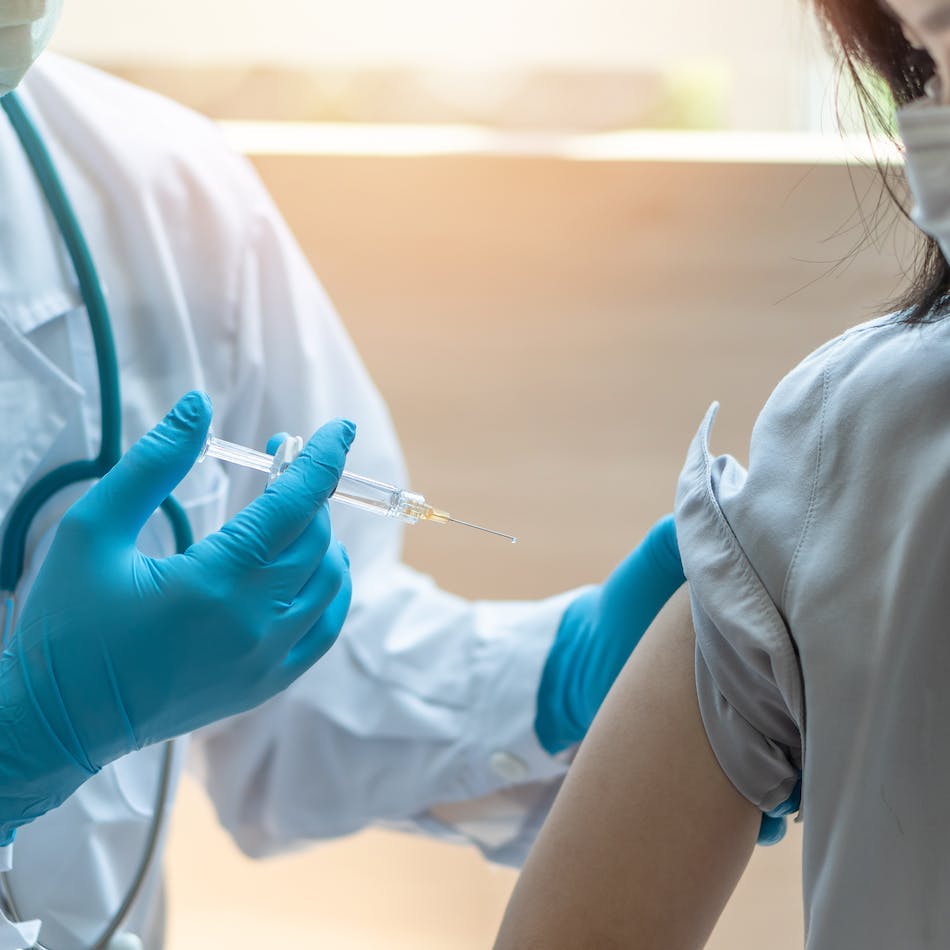COVID-19 Vaccines Are Here: What Employers Should Keep in Mind
By Newfront | Published December 11, 2020

UPDATE: The Food and Drug Administration authorized Pfizer’s Covid-19 vaccine for emergency use on Friday, clearing the way for millions of highly vulnerable people to begin receiving the vaccine within days.
The first COVID-19 vaccine, developed by Pfizer and BioNTech SE, passed a crucial milestone yesterday, as a panel of experts formally recommended the Food and Drug Administration authorize the vaccine. While likely the administration will do so within days, the vaccine faces huge hurdles to overcome in terms of human and physical logistics for rolling out the vaccine, which, initially, is in limited supply. Thankfully, the U.S. government is committed to providing COVID-19 vaccinations free of charge to all Americans.
Vaccinating every American who wants to be vaccinated will not be easy, while the ultimate goal, it requires a phased approach. Within 24 hours of receiving emergency use authorization (EUA), 2.9 million doses of the Pfizer vaccine will be sent to all 50 states, each of which will determine who gets priority. The Centers for Disease Control and Prevention (CDC) has published a COVID-19 vaccination program interim playbook for state and local health officials that provides guidance on identifying “critical populations,” which will include:
Healthcare personnel and other critical infrastructure workers
People at increased risk for severe COVID-19 illness (e.g., people who have underlying medical conditions or are 65 years of age and older)
People at increased risk of acquiring or transmitting COVID-19 (e.g., educational workers or racial and ethnic minority groups)
People with limited access to routine vaccination services (e.g., people with disabilities, the uninsured, or rural communities)
Phase 1 of the vaccine, when supply is limited, will be distributed to healthcare workers and the elderly in long-term-care facilities will get the vaccine first, followed by people who play a key role in keeping essential functions of society running and who cannot socially distance in the workplace. As more doses and vaccines become available—a vaccine from Moderna is up next for approval—Phase 2 should cover the remaining critical populations. Once there is sufficient supply (or even a surplus) of vaccine doses, Phase 3 should focus on ensuring equitable vaccination access to the entire population. Unfortunately for most states, that initial shipment of the vaccine will inoculate less than 1% of their populations.
But let’s consider how fortunate we are. That’s not only a start. It’s a miracle. Vaccines for new viruses have historically taken decades to develop: 47 years for polio, 42 years for chickenpox, 43 years for Ebola. Even the hepatitis B vaccine took 16 years to develop. The first vaccines for this novel coronavirus were developed in mere months. That doesn’t mean corners were cut. These vaccines were developed and approved with the same processes and procedures as any vaccine available today. Here’s what employers should keep in mind as more vaccines and doses become available.
Provide Education and Encourage Vaccination
As an employer, if you haven’t yet developed your vaccine communication strategy, now is the time. While cost won’t be at issue, employees’ willingness to be vaccinated could hamper your return-to-work plans. With the accelerated development, documented side effects, and questionable long-term efficacy of the Pfizer vaccine, a recent poll showed that from 30% to as much as 50% of the U.S. population would not be willing to be vaccinated, depending on the vaccine.
In a December 8, 2020 video interview, Jonathan Rockoff of The Wall Street Journal asked Dr. Anthony Fauci, director of the National Institute of Allergy and Infectious Disease, what guidance he would give CEOs on when their employees should be starting to get vaccinated and when they can bring them back to the buildings—referring to the general and otherwise healthy population. Dr. Fauci responded:
“This is the critical issue. If we can convince the overwhelming majority of the U.S. population to take the vaccine, when we get through April, May, and June, we could likely get most everybody and anybody who can get vaccinated to be vaccinated. The quicker we do that, the quicker we’ll be able to tell the CEOs who are listening and viewing that they’re going to be close to normal. Once you get an umbrella of herd immunity, as we refer to it, where you have 75% or more of the population vaccinated in this country, the level of circulating virus in the community, by definition, will be so low that the threat of outbreaks in whatever facility, factory, industry or whatever it is that you’re the CEO of is going to be extremely low. We’re not going to be able to immediately abandon public health measures… the mask wearing and the care about indoor settings… but the stringency of that and requirement of that will progressively diminish as we get more and more of the herd immunity.”
Some of our clients have asked about whether they should make the vaccine mandatory or offer incentives to employees for getting vaccinated. While the Equal Opportunity Commission (EEOC) has, during past pandemics, said that employers could make vaccinations mandatory as long as they made exceptions for people with disabilities or religious objections, their recommendation was that employers encourage, rather than mandate, vaccination. As for incentives, the key thing to remember is equity. If you offer an incentive for getting vaccinated, you must also be willing to provide that same incentive to people who cannot be vaccinated for a valid reason (e.g., pregnancy, disability, or religious objection).
Guidance from the CDC—and the EEOC, OSHA, and state and local governments—is being updated continually. Now that a vaccine has been approved, look for new updates. Until then, the best strategy is to start setting expectations and communicating the facts about COVID-19 vaccines, along with the benefits of getting a COVID-19 vaccine, to employees now and continually in the coming weeks and months. As more people become successfully vaccinated, more people will be willing to get vaccinated, and that’s when we’ll really get ahead of this virus.
Confirm Coverage
The Coronavirus Aid, Relief, and Economic Security (CARES) Act requires non-grandfathered group health plans and health insurance issuers offering group or individual health insurance to cover (without cost-sharing) any qualifying COVID-19 preventive service, including care and immunization, within 15 business days after it has been recommended by the U.S. Preventive Services Task Force (USPSTF) or the CDC’s Advisory Committee on Immunization Practices (ACIP). With an EUA, the Pfizer vaccine may be technically considered experimental and may not be called out in a benefits plan specifically, but it is covered by the CARES Act. Employers should confirm with their medical insurance carrier and claims administrator that they are able to administer coverage in the timeframe required.
While this mandate to cover preventative services is permanent, the requirement to cover diagnostic (testing) services will end when the public health emergency ceases to exist—and that’s up to the Department of Health and Human Services (HHS). On October 23, 2020, the HHS Secretary renewed the public health emergency for COVID-19. Each renewal lasts for 90 days unless HHS determines that the public health emergency no longer exists and terminates the pronouncement at an earlier date. Right now, the coverage requirement for testing will end on January 21, 2021, unless extended or terminated. Given the timing outlined by Dr. Fauci, we can expect this public health emergency to be extended for another 90 days.
Remain Diligent
According to a study published in the American Journal of Preventive Medicine, a vaccine would need to be at least 80% effective, with about 75% of a population receiving it, to extinguish an epidemic without any other public health measures. We’ve got a long way to go. But vaccinations combined with responsible behaviors will get us there faster. Keep wearing your masks, washing your hands, social distancing, and only gathering indoors with the people in your own household—truly. No sneaking off to see your grandparents!
With the holidays upon us, employers have more latitude than normal this year to ask about, restrict, or monitor employee behavior during off-hours. Employers are required to provide a safe workplace, but what you can and cannot do to ensure one will depend on the laws of your state. For example, employers can ask employees to disclose travel plans and enforce post-travel quarantines. They can also discipline employees for what they do or don’t do when they are off the clock—say, if they are caught on social media violating state or local health mandates.
Employers should continue to do everything they can to enable employees to protect themselves and their loved ones by complying with the guidelines and mandates from the CDC and their state, county, and local governments. When someone gets vaccinated, restrictions may still be in place and should certainly be followed. Even after a majority of the population is vaccinated, restrictions may still be in place. Those restrictions will start relaxing eventually, but life—and work—as we know it has changed forever.
The question now is: How will we use what we’ve learned this year to make the world and workplace safer, more adaptable, and more resilient in the years to come?

Newfront
Newfront is a modern brokerage transforming the risk management, business insurance, total rewards, and retirement services space through the combination of elite expertise and cutting-edge technology. Specializing in more than 20 industries and headquartered in San Francisco, Newfront has offices nationwide and is home to more than 800 employees serving organizations across the United States and globally.

